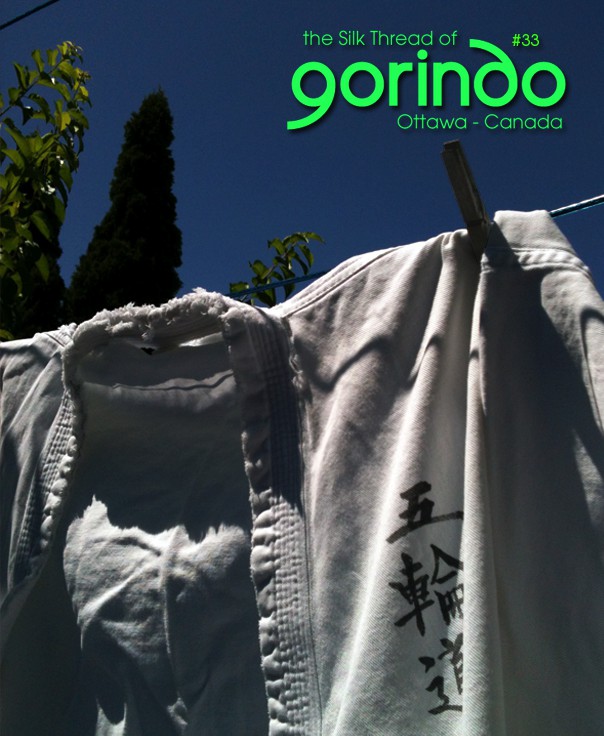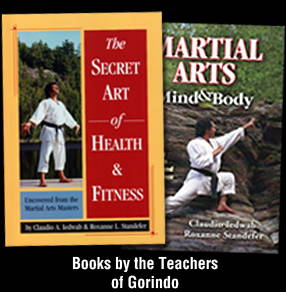
The Silk Thread of Gorindo - Ottawa - Canada
- What's Self-Defense - Part 1
Cover 'Hanging Out' - Photo by ©2013 Claudio Iedwab
What's Self-Defense - Part 1

Many people become involved in the martial arts because they wish to learn how to defend themselves.
Quite naturally, they presume that they will learn to punch, kick, and overthrow their opponent, but do they really know what they are preparing to defend themselves against? Although we all share to some degree a primeval fear of the dark, it is more likely that our fear of alleys and parking lots comes from the dark corners of prime time TV. Still, although the risk of attack from a mugger or rapist on the street is very small, it is nevertheless real.
Short courses for women in self-defense, and anti-rape devices such as pepper spray and shrieking horns are popular, but opinion varies on their usefulness. Although old-fashioned ideas about submitting to rape to avoid further injury are generally rejected, even trained martial artists agree that it is not worth fighting an armed attacker over a wallet or watch. Clearly the rules of engagement are not simple and the meaning of self-defense is more complicated than it at first appears.
Let us begin, then, with an understanding of what we are trying to protect. Every man, woman, and child has the right to personal liberty, privacy, and autonomy.
We adjust these rights within the reasonable limits imposed by our need to gather in social groups.
Although we traditionally come together to accomplish certain shared goals, on a personal level we all wish to go about our business without hindrance; we want to eat, sleep, work, spend good times with family and friends, and limit our exposure to fear, pain, and violence. This utopian vision, is in fact, a fairly accurate portrait how most of us do spend our lives in modern, wealthy democracies. Although different cultures view the necessity of the telephone, hot and cold running water, and the two-car garage quite differently, our basic needs as humans for health and happiness are fundamentally the same. Ultimately, it is not our possessions but our health and happiness that we wish to protect from harm.
Martial artists practice the art of self-defense in all its conventional aspects, but go further in using the same principles to avoid and deflect attacks on their physical, mental, and spiritual well-being. Improved awareness, good powers of observation, quick reflexes, and precise evasive movements will all come in handy in other areas of our lives. Just stepping off the curb to cross a street as a distracted or aggressive driver careens around the corner, presents a dangerous situation. The skills and faculties developed through martial arts training can help us escape. Stress reduction and anger management through relaxation and meditation will limit the chances of heart disease, stroke, and cancer, and generally make life calmer and more pleasant. Strengthened spiritual fortitude and a well-developed sense of self allow us to deal with the emotions involved when misfortune does strike, and can be one of the most valuable benefits of martial arts training.
Broadening the scope of self-defense into one that is more personal and truly of the “self” helps to build a framework for both the ethical and practical aspects of the pursuit of the martial arts. One must remember that the traditions and history of martial arts range from the peaceful Shaolin monks, who learned to defend themselves when their vows would not allow the use of weapons, through the samurai who seemed to be rising constantly, sword in hand, to some challenge to their personal honor or that of their master, to the present day spiritual warrior who pursues the ancient art of tai chi chuan in a park.
Many people have been deterred from the practice of martial arts simply because they don’t want to hurt anybody. Probably equal in numbers are those who don’t wish to get injured themselves, and are uncertain of how potentially lethal techniques can be learned without someone being hurt. However, as we have seen, it is precisely because of the respect, traditions, and attention to consistant progressive practice, that the long-term study of martial arts can offer a safe, effective approach to self-defense.
Although learning a few techniques in a seminar or a magazine article may in fact save someone’s life, the benefits of these experiences should not be confused with the rewards of a serious study of martial arts.
The difference between a woman who has just learned the eye poke, throat jab, or the traditional knee to the groin, and a woman practicing at an advanced level in a well-rounded martial arts school, is the degree of freedom from fear she experiences when walking down the street. The well-trained martial artist will still exercise caution and vigilance in her daily life, and not entertain illusions about being invulnerable to attack. However, she knows that if such a rare attack occurs, she possesses a range of well-practiced options, from escape to complete immobilization of the assailant. Depending upon the situation, she might even use her training to stay calm and talk her way out of immediate danger. The point is that her training allows her choices, including non-lethal restraining techniques, whereas the novice has no recourse but to the single, radical technique she has been taught.
Obviously, it is not only women who are subject to violence and experience the immobilizing fear of attack. Many men join martial arts schools to learn self-defense, but for some reason are less willing to admit that motivation to others.
People with little training who find themselves in violent situations are often frozen by the enormity of having their worst fears realized, and this is compounded by the awful realization that they might have to kill someone to escape. The long-term effects of the violence on the psyche of those who survive such attacks can sometimes be worse than any physical damage.
Excerpt from “The Secret Art of Health & Fitness – Uncovered from the Martial Arts Masters” published book by Claudio Iedwab & Roxanne Standefer available at askSensei.com >>
Photos by ©2013 Roxanne Standefer
- What's Self-Defense - Part 1
« Click the Subscribe link on the left




